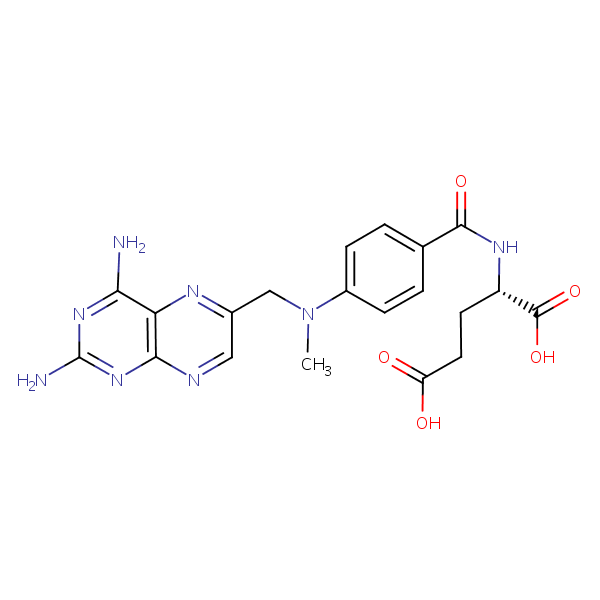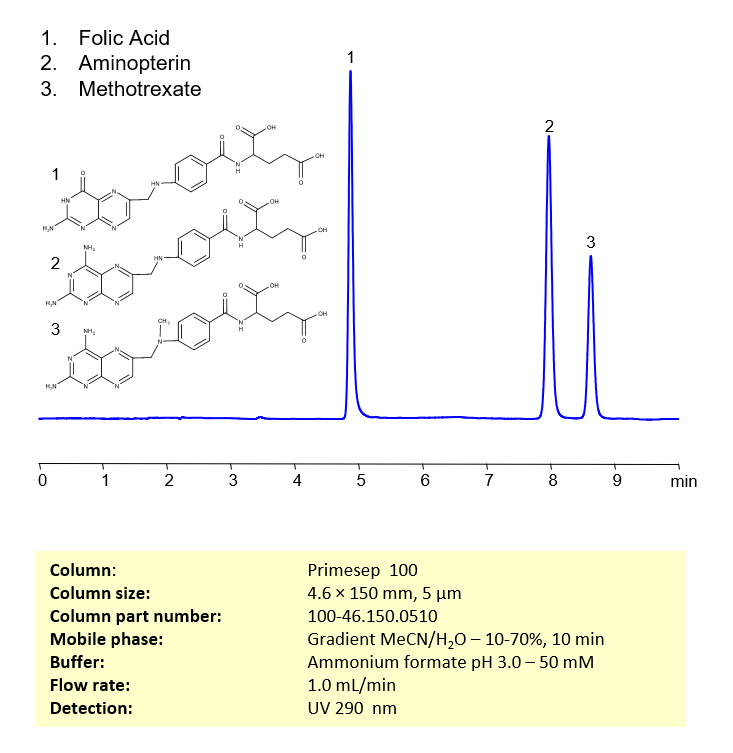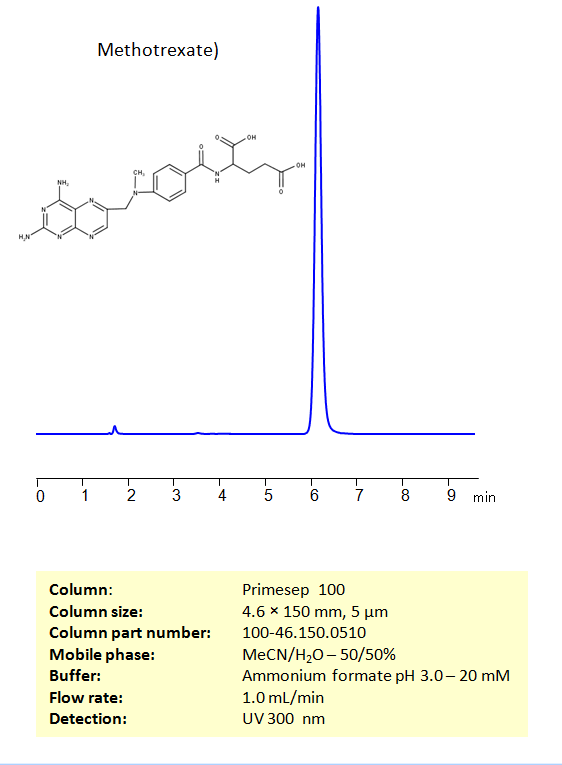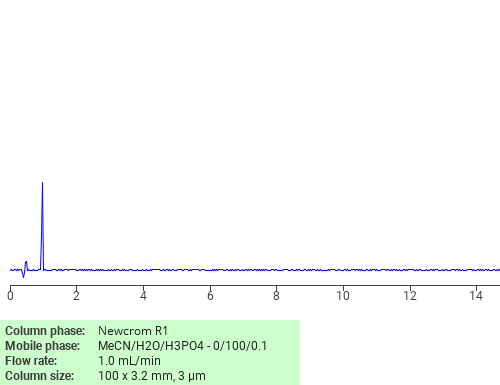| CAS Number | 59-05-2 |
|---|---|
| Molecular Formula | C20H22N8O5 |
| Molecular Weight | 454.447 |
| InChI Key | FBOZXECLQNJBKD-ZDUSSCGKSA-N |
| LogP | -1.85 |
| Synonyms |
|
Applications:
HPLC Method for Separation of Folic Acid, Methotrexate and Aminopterin on Primesep 100 Column
June 12, 2023
HPLC Method for Separation of Methotrexate, Aminopterin, Folic Acid on Primesep 100 by SIELC Technologies
Separation type: Liquid Chromatography Mixed-mode
Aminopterin and folic acid are chemically related compounds that play significant roles in biochemistry and medicine.
Methotrexate, Aminopterin, and Folic Acid are chemically related compounds that have important roles in biochemistry and medicine.
- Methotrexate: This is a chemotherapy agent and immune system suppressant. Methotrexate is an antimetabolite and antifolate drug, meaning it inhibits the metabolism of folic acid. It does this by inhibiting the enzyme dihydrofolate reductase (DHFR), preventing the formation of active folate and thus interfering with DNA and RNA synthesis. It is used to treat certain types of cancer and autoimmune diseases like rheumatoid arthritis and psoriasis.
- Aminopterin: This is also an antifolate, and it works in a similar way to methotrexate, by inhibiting the enzyme DHFR. Aminopterin was one of the first antifolates to be used in cancer chemotherapy. However, it has largely been replaced by methotrexate, which is less toxic and more effective.
- Folic Acid: Also known as folate or vitamin B9, this is an essential nutrient that the body needs for many functions. It’s critical for the synthesis, repair, and functioning of DNA, as well as for cell division and growth. A deficiency of folic acid can lead to anemia and other health problems.
The antifolate drugs methotrexate and aminopterin are designed to interfere with the actions of folic acid, making them effective in slowing down the growth of rapidly dividing cells, such as cancer cells. However, this can also affect normal, healthy cells, leading to side effects.
Aminopterin, methotrexate and folic acid can be retained, separated, and analyzed using a reverse-phase Primesep 100, 4.6 x 150 mm, 5 µm, 100 A, dual ended column. The mobile phase for this method consists of water, acetonitrile (MeCN), and ammonium formate, which serves as a buffer. This analytical method can be monitored using UV detection at 290 nm, an Evaporative Light Scattering Detector (ELSD), or any other evaporative detection method such as Charged Aerosol Detection (CAD) or Electrospray Ionization Mass Spectrometry (ESI-MS)
LOD was determined for this combination of instrument, method, and analyte, and it can vary from one laboratory to another even when the same general type of analysis is being performed.
High Performance Liquid Chromatography (HPLC) Method for Analysis of Methotrexate, Aminopterin, Folic Acid
Condition
| Column | Primesep 100, 4.6 x 150 mm, 5 µm, 100 A, dual ended |
| Mobile Phase | Gradient MeCN -10-70%, 10 min |
| Buffer | Ammonium formate pH 3.0 – 50 mM |
| Flow Rate | 1.0 ml/min |
| Detection | UV 290 nm |
| Peak Retention Time | 5.08 min, 8.32 min |
| Sample concentration | 0.02 mg/ml |
| Injection volume | 5 µl |
| Sample diluent | H2O+NaOH |
| LOD | 0.04 ppm |
Description
| Class of Compounds | Drug, Aminopterin, Antifolates, Acid |
| Analyzing Compounds | Methotrexate, Aminopterin, Folic Acid |
Application Column
Primesep 100
Column Diameter: 4.6 mm
Column Length: 150 mm
Particle Size: 5 µm
Pore Size: 100 A
Column options: dual ended
Folic Acid
Methotrexate

HPLC Method for Analysis of Methotrexate on Primesep 100 Column
June 9, 2023
HPLC Method for Analysis of Methotrexate on Primesep 100 by SIELC Technologies
Separation type: Liquid Chromatography Mixed-mode
Methotrexate is a chemotherapy agent and immune system suppressant. It is classified as an antimetabolite and antifolate drug. Methotrexate works by inhibiting the enzyme dihydrofolate reductase (DHFR), preventing the formation of active folate and thus interfering with DNA and RNA synthesis.
Due to its mechanism of action, methotrexate is used to treat certain types of cancer, such as leukemia, breast cancer, lung cancer, and osteosarcoma. It is also used in the treatment of autoimmune diseases, including rheumatoid arthritis and psoriasis, as it can decrease the activity of the immune system.
Like all medications, methotrexate can cause side effects and should be used under the supervision of a healthcare provider. Always consult with a healthcare professional for the most accurate and up-to-date information.
This is a chemotherapy agent and immune system suppressant. Methotrexate is an antimetabolite and antifolate drug, meaning it inhibits the metabolism of folic acid. It does this by inhibiting the enzyme dihydrofolate reductase (DHFR), preventing the formation of active folate and thus interfering with DNA and RNA synthesis. It is used to treat certain types of cancer and autoimmune diseases like rheumatoid arthritis and psoriasis.
Methotrexate retained and analyzed using a reverse-phase Primesep 100, 4.6 x 150 mm, 5 µm, 100 A, dual ended column. The mobile phase for this method consists of water, acetonitrile (MeCN), and ammonium formate, which serves as a buffer. This analytical method can be monitored using UV detection at 290 nm, an Evaporative Light Scattering Detector (ELSD), or any other evaporative detection method such as Charged Aerosol Detection (CAD) or Electrospray Ionization Mass Spectrometry (ESI-MS)
LOD was determined for this combination of instrument, method, and analyte, and it can vary from one laboratory to another even when the same general type of analysis is being performed.
High Performance Liquid Chromatography (HPLC) Method for Analysis of Methotrexate
Condition
| Column | Primesep 100, 4.6 x 150 mm, 5 µm, 100 A, dual ended |
| Mobile Phase | MeCN/H2O -50/50% |
| Buffer | Ammonium formate pH 3.0 – 20 mM |
| Flow Rate | 1.0 ml/min |
| Detection | UV 290 nm |
| Peak Retention Time | 6,12 min |
| Sample concentration | 0.1 mg/ml |
| Injection volume | 5 µl |
| Sample diluent | H2O + NaOH |
| LOD | 34 ppb |
Description
| Class of Compounds | Drug, Aminopterin, Antifolates |
| Analyzing Compounds | Methotrexate |
Application Column
Primesep 100
Column Diameter: 4.6 mm
Column Length: 150 mm
Particle Size: 5 µm
Pore Size: 100 A
Column options: dual ended

Separation of Methotrexate on Newcrom R1 HPLC column
February 16, 2018
Methotrexate is a drug used in chemotherapy and in suppressing the immune system. It is used to treat a lot of cancers and autoimmune diseases. Methotrexate can be analyzed by this reverse phase (RP) HPLC method with simple conditions. The mobile phase contains acetonitrile (MeCN), water, and phosphoric acid. For Mass-Spec (MS) compatible applications the phosphoric acid needs to be replaced with formic acid. Smaller 3 µm particle columns are available for fast UPLC applications. This liquid chromatography method is scalable and can be used for isolation of impurities in preparative separation. It also suitable for pharmacokinetics.
.
Application Column
Newcrom R1
The Newcrom columns are a family of reverse-phase-based columns. Newcrom A, AH, B, and BH are all mixed-mode columns with either positive or negative ion-pairing groups attached to either short (25 Å) or long (100 Å) ligand chains. Newcrom R1 is a special reverse-phase column with low silanol activity.
Select options





